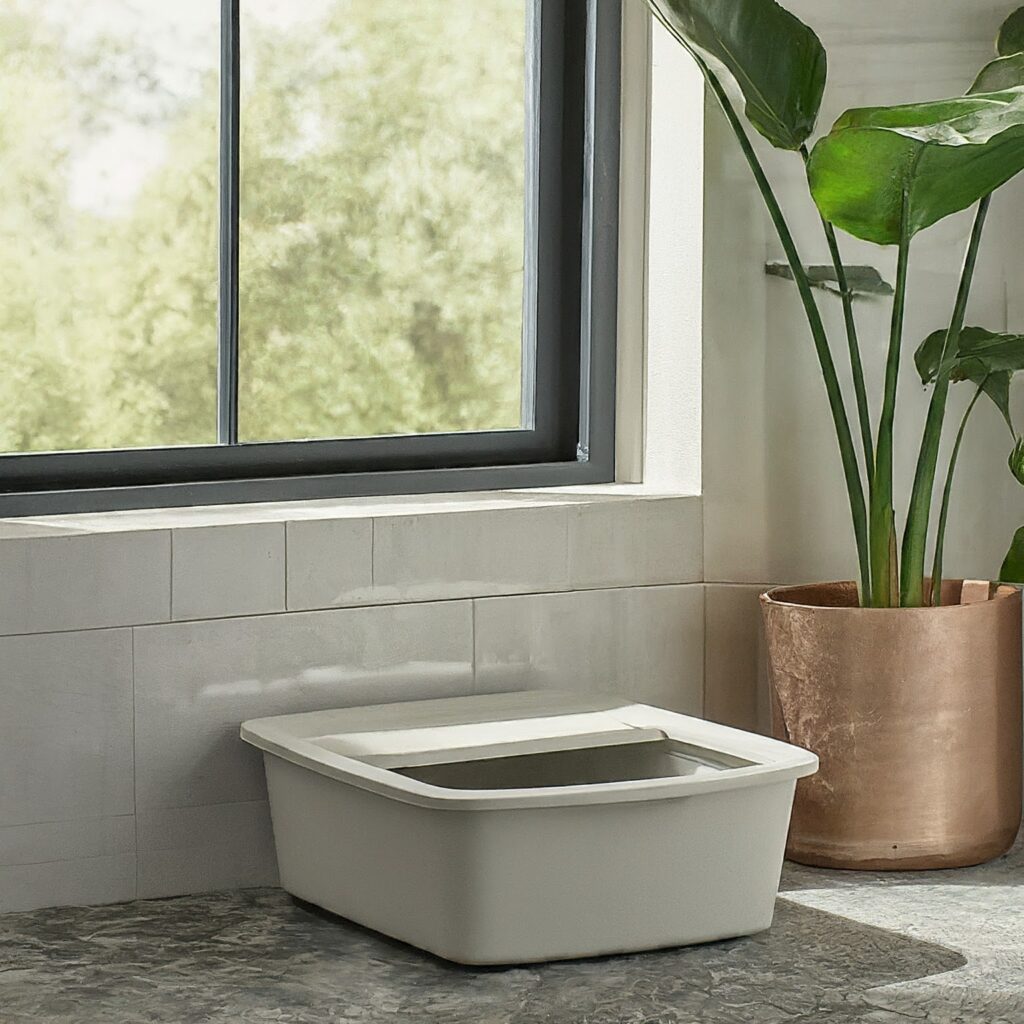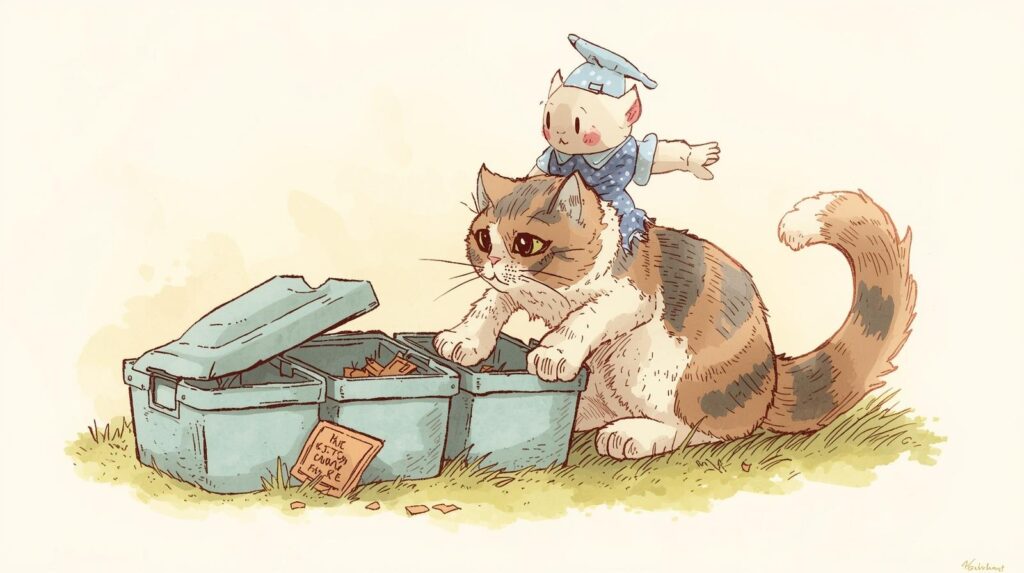
Does your cat’s litter box have tiny flying bugs? You’re not alone. Many cat owners see gnats in cat litter, and it can feel gross and confusing. These bugs seem to show up out of nowhere and don’t leave. But don’t worry! We’ll tell you why they come, if they are dangerous, and how to get rid of them fast.
In this blog, you’ll learn:
- Why gnats’ cat litter is a real problem
- Dangers of these bugs for cats and people
- 9 smart ways to fix the issue quickly
Let’s make your litter box clean and bug-free!
Table of Contents
Why Are Gnats in Cat Litter?
Gnats’ cat litter problems usually start when your litter box gets too moist or dirty. Gnats are tiny flying bugs that love damp places. Litter boxes that are not cleaned daily or have wet clumps are perfect for them.
Why do they appear?
- Wet cat urine and poop
- Warm and moist rooms
- Leftover food near the litter area
- Dirty litter that hasn’t been changed
There are different types of gnats:
- Fungus gnats – love moisture and plant soil
- Fruit flies are attracted to food smells
- Drain flies – come from dirty drains nearby
These gnats fly near the litter box, lay eggs, and cause a mess.
5 Warning Signs You Have Gnats in Cat Litter

It’s not always easy to notice gnats at first. But here are signs that show they’re around:
- 🪰 Small black or grey bugs flying near the litter box
- 👃 A strong smell or ammonia scent from the box
- 🐱 Your cat avoids using the litter
- 🧫 You see tiny worm-like larvae in the litter
- 🍽️ Gnats flying near your pet’s food bowls
If you notice these signs, you need to act fast before it turns into a full gnat infestation.
The Hidden Dangers of Gnats for Cats & Humans

You might think gnats are just annoying bugs, but they can cause real problems, especially around your cat’s litter box.
🐱 For Cats:
- Skin Irritation: Some gnats bite, making your cat itch or scratch more than usual.
- Eye & Nose Trouble: Constant buzzing may bother sensitive areas like the eyes or nose.
- Stress & Litter Avoidance: Cats hate mess. If gnats keep flying around, your cat may avoid using the litter box and hold in poop or pee, which can cause bladder infections or constipation.
- Infections: Dirty litter attracts bacteria. Gnats can carry those germs to your cat’s food, fur, or paws, leading to possible wounds or stomach issues if your cat licks them.
👨👩👧👦 For Humans:
- Hygiene Problems: Gnats land on dirty litter, then fly to your kitchen, food, or toothbrush—spreading bacteria.
- Allergies & Breathing Issues: Gnats in large numbers may increase indoor allergens.
- Embarrassment: Bugs flying around litter can make your home feel unclean to visitors.
Gnats may be small, but they can harm your cat’s health and lower the cleanliness of your home. That’s why keeping your litter box clean and dry is so important.
How to Get Rid of Gnats in Cat Litter – Step-by-Step Guide
If you’ve spotted tiny flying bugs near your cat’s litter box, don’t ignore it. Gnats multiply fast and can make your cat avoid the litter. Follow these detailed steps to stop them and prevent them from coming back.
Step 1: Scoop the Litter Box Every Day
Why it matters:
Gnats love cat waste, especially moist urine clumps. If you skip a day, it gives them a perfect breeding spot. Even if it looks “not too dirty,” it can still attract bugs.
What to do:
- Scoop all poop and urine clumps at least once a day, or even twice if possible.
- Use a fine-mesh scooper to catch small clumps.
- Throw waste in a sealed trash bin—don’t leave it open indoors.
Tip: If you’re busy, set a phone reminder or scoop right after your cat uses the box.
Step 2: Change the Entire Litter Weekly
Why it matters:
Even when you scoop daily, leftover litter absorbs smells and moisture. Over time, this creates an environment where gnat eggs can survive.
What to do:
- Empty the whole litter box once every 7 days.
- Use gloves and wear a mask if you’re sensitive to dust or smells.
- Do this outdoors if possible to avoid spreading dust indoors.
Tip: Don’t just top off old litter with new—replace it fully.
Step 3: Clean the Litter Box with Vinegar
Why it matters:
After removing the litter, cleaning the box kills bacteria, removes gnat eggs, and cuts odors.
What to do:
- Mix 1 part white vinegar with 1 part hot water.
- Scrub all sides of the box with a brush or sponge.
- Rinse well and let it air dry before refilling.
Bonus Tip: Avoid bleach—it can leave behind fumes harmful to cats.
Step 4: Use Low-Moisture, Natural Cat Litter
Why it matters:
Clumping clay litter can hold moisture longer, which attracts gnats. Natural litters like pine pellets or paper-based litter stay drier and are less attractive to bugs.
What to do:
- Try switching to pine, walnut, crystal, or paper litter.
- Avoid “scented” litter—they may hide smell from humans, but not from gnats.
Tip: Observe how your cat reacts. Some cats need a slow switch to a new type.
Step 5: Improve Airflow Around the Litter Box
Why it matters:
Gnats love warm, stuffy places. Fresh air helps dry the litter faster and prevents gnat breeding.
What to do:
- Place the box in a well-ventilated spot.
- Use a small fan (pointed away from the box) to keep air moving.
- Open nearby windows if safe.
Tip: Never keep litter in humid rooms like bathrooms or near laundry dryers.
Step 6: Keep Plants Away from the Litter Area
Why it matters:
Fungus gnats often come from potted plants. If your cat’s litter is near them, gnats will move back and forth between the soil and litter.
What to do:
- Move all houseplants to a different room.
- Cover the plant soil with small pebbles to block bugs if needed.
- Don’t overwater plants—it creates the same damp conditions gnats love.
Tip: Use yellow sticky traps near plants to reduce gnat populations.
Step 7: Set Up Apple Cider Vinegar Gnat Traps
Why it matters:
You can’t kill every gnat by cleaning alone. Traps help catch the remaining adult gnats in the area.
What to do:
- Fill a small bowl with apple cider vinegar.
- Add a few drops of dish soap.
- Place the bowl near (not inside) the litter box.
Tip: Keep it away from pets—cats may try to drink it.
Step 8: Seal Garbage and Litter Disposal Bags
Why it matters:
Leaving litter waste or food trash open inside the house invites gnats. They follow the smell and may return to the litter box.
What to do:
- Always tie litter waste in double-sealed bags.
- Keep garbage bins tightly covered.
- Take out the trash regularly—don’t wait for it to pile up.
Tip: Use bins with a step lid or lock to keep bugs out.
Step 9: Use Pet-Safe Gnat Repellents Around the Litter Box
Why it matters:
After cleaning, gnats may still hover nearby. Repellents give extra protection and discourage them from coming back.
What to do:
- Use cat-safe sprays with natural oils like lemon, rosemary, or cedarwood.
- Spray around the litter box area (not inside the box).
- Try diatomaceous earth around the base of the box—it’s safe for pets and deadly to bugs.
Tip: Never use strong chemical sprays near cats. Their bodies are more sensitive than ours.
These steps work. Stay clean and dry, and the gnats will go!
You can also read: Maggots in the litter box
Best Cat Litter Types That Don’t Attract Gnats
| Litter Type | Gnat Resistance | Odor Control | Dust Level | Good for Cats? | Notes |
|---|---|---|---|---|---|
| Pine Pellet Litter | ⭐⭐⭐⭐⭐ Very High | ⭐⭐⭐⭐ Good | ⭐ Low | ✅ Most cats adapt | Natural, controls moisture |
| Paper Pellet Litter | ⭐⭐⭐⭐ High | ⭐⭐⭐ Moderate | ⭐ Very Low | ✅ Great for seniors | No clay, soft on paws |
| Silica Crystal Litter | ⭐⭐⭐⭐⭐ Very High | ⭐⭐⭐⭐⭐ Excellent | ⭐⭐ Very Low | ⚠️ Some dislike feel | Dries fast, kills odor |
| Walnut Shell Litter | ⭐⭐⭐⭐ High | ⭐⭐⭐⭐ Good | ⭐⭐ Low | ✅ Eco-friendly | Naturally antimicrobial |
| Clay Clumping Litter | ⭐ Low | ⭐⭐⭐⭐ Good | ⭐⭐⭐ High | ✅ Most preferred | Moisture attracts gnats |
| Corn-Based Litter | ⭐⭐ Medium | ⭐⭐⭐ Moderate | ⭐⭐ Low | ⚠️ Some allergies | Dries fast, kills odour |
Tip for Readers:
Look for litters labelled “low moisture”, “unscented”, or “natural plant-based” to reduce gnat attraction. Avoid litters that stay wet or create too much dust. Try natural and low-dust litters. They are better for your cat and help stop gnat problems.
Common Mistakes That Make Gnats Worse
Avoid these errors to reduce gnats’ cat litter troubles:
- ❌ Leaving the litter dirty for days
- ❌ Using air fresheners (masks smell but not the source)
- ❌ Placing the box in dark, humid spots
- ❌ Keeping open food or garbage near the box
- ❌ Not drying the box after washing
You can also read: When is it too late to litter train a cat
Safe DIY Gnat Traps (That Actually Work)
These homemade traps help reduce gnats and cat litter issues without using chemicals:
- 🍎 Vinegar Trap: Apple cider vinegar + dish soap in a bowl
- 🍋 Lemon Clove: A cut lemon with cloves repels bugs
- 📄 Sticky Paper: Hang traps near the litter zone
- 🪨 Diatomaceous Earth: Sprinkle around (not in) the box to kill bugs naturally
YOU CAN ALSO READ: Cat pee turns litter to mud
When to Call a Pest Control Expert
If gnats cat litter solutions don’t work after a week:
- You see bugs all over the house
- Gnats appear in drains or walls
- Your cat stops eating or using the box
- DIY traps and cleaning don’t solve it
Call a professional to check for hidden infestations.
FAQs About Gnats Cat Litter (Top 10)
1. Why are there gnats in my cat litter box?
Gnats are attracted to the moisture and ammonia odour found in dirty cat litter. If you skip daily scooping, it creates a breeding ground for fungus gnats and other cat litter bugs. They thrive in organic waste, especially if your litter box is placed in a humid or low-airflow area.
2. Can gnats harm my cat?
Yes—gnats in cat litter can stress your pet, irritate their skin, and even lead to litter box avoidance, which risks urinary tract infections. Some gnats may also carry bacteria, creating a hygiene risk. These pests aren’t just gross—they can cause real health problems for both your cat and your household.
3. How can I stop gnats from returning to the litter?
The key is moisture control and odor elimination. Scoop clumps daily, replace all litter weekly, and use a low-dust, biodegradable litter like pine or paper. Place apple cider vinegar traps nearby and remove houseplants or organic matter that might attract gnats. Focus on litter box hygiene and airflow.
4. What is the best litter for stopping gnats?
Use low-moisture cat litter like silica crystals, pine pellets, or recycled paper litter. These types dry faster and don’t hold odor like clumping clay litter, which attracts gnats. Look for natural litter types that are unscented and fast-drying to prevent breeding grounds.
5. Are scented litters good for keeping gnats away?
No. Scented litters mask odor from humans, but not from gnats. In fact, the added fragrances may irritate your cat’s lungs or discourage them from using the box. The best way to fight odor and gnats is through regular cleaning and proper litter box placement, not artificial scents.
6. Can gnats come from houseplants?
Yes—fungus gnats often start in the moist soil of indoor plants. If your litter box is near potted plants, the bugs can migrate from plant soil to the litter. Keep plants and compostable material far from the litter area, and use insect-control soil toppings to stop the cycle.
7. How do I clean the litter box to kill gnats?
Use hot water mixed with white vinegar to scrub the litter box weekly. This natural method kills gnat eggs, removes bacteria, and eliminates odor buildup. Always dry the box completely before refilling with fresh litter to block gnat reproduction in damp litter environments.
8. Can vinegar traps really catch gnats?
Absolutely! These are one of the best DIY gnat control methods. A bowl of apple cider vinegar with dish soap breaks surface tension, causing gnats to sink and die. Place traps near litter but out of your cat’s reach. It’s a safe, chemical-free solution for indoor fly control.
9. Do gnats lay eggs in cat litter?
Yes. Gnats lay eggs in moist, dirty litter where organic material is present. If your litter is clumped and left for days, it becomes a breeding zone. Eggs hatch into larvae (tiny white worms), often seen wriggling in the litter. Fast action stops a full litter box infestation.
10. When should I call pest control?
If cleaning, traps, and litter box maintenance tips fail within a week, and gnats start appearing throughout your home or near drains, it’s time to call a professional pest control service. They can locate hidden breeding zones and stop indoor insect infestations from spreading.
Final Thoughts: Keep the Litter Box Clean & Gnat-Free
Solving a gnats cat litter problem is all about prevention, not just reaction. When you take small, consistent steps, you can avoid future infestations and keep your cat comfortable.
✅ Key Takeaways for a Gnat-Free Litter Box:
- Clean the litter box daily to avoid moisture and odour buildup—key causes of cat litter bugs.
- Use low-moisture cat litter like pine pellets or silica crystals to prevent gnat breeding.
- Improve airflow around the box to discourage fungus gnats and other flying pests.
- Stick to biodegradable litter or unscented litter to protect your cat’s health and reduce pest attraction.
- Follow natural litter box cleaning tips, like using vinegar and water weekly.
- Set up DIY gnat traps using apple cider vinegar to catch stragglers safely.
By focusing on moisture control, odour elimination, and regular cleaning, you’ll stop gnats in cat litter from ever becoming a major issue again.



